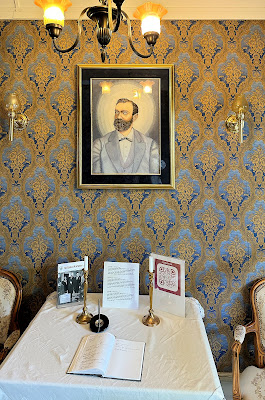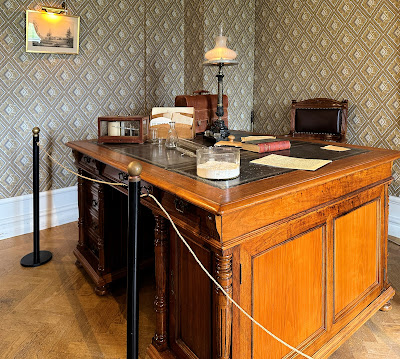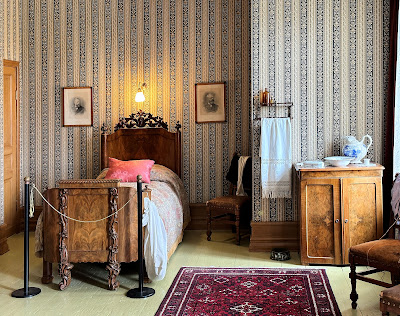Karlskoga

|
|
The sign reads:
This armor plate was used in delivery tests in 1815 for Bofors 305 mm armor-piercing shells for Argentina. |
Already as a boy, Alfred was interested in explosives, learning the basic principles from his father, an engineer. No wonder his first Swedish patent of 1863 was on "ways to prepare gunpowder."

|
| Nobel's bust in front of Björkborn herrgård |

|
| At the entrance of the museum, the Altar |

|
| His mistress |

|
| His desk |

|
| The most important item at the museum is Kieselguhr |
According to legend, the chance finally helped. In 1866, during one of the numerous ways of transporting nitroglycerine, an incident occurred in which one of the transport containers leaked. The liquid dripped onto the loading area of the transport wagon, which was padded with Kieselguhr (diatomaceous earth). The result was a mushy mash that workers brought to Nobel's attention.
Kieselguhr was the inert absorbent substance Nobel had been looking for. Now it was safer and more convenient to handle nitroglycerine. Nobel called the new product Dynamite.

|
| Nobel's bedroom |

|
| Nobel's six-shooter. Is it a Colt caliber 45 Peacemaker? |

|
| There He was. |
Although Nobel apparently made more money with Gelignite, a plastic, kneadable explosive, Dynamite became a bestseller.
Mariefred
Gripsholm on Lake Mälaren in Mariefred is one of the most famous castles in Sweden. This mighty and picturesque building served Kurt Tucholsky as the name for a novel.
The name Gripsholm* goes back to Bo Jonson (Grip), who built a castle in 1380. This aristocrat dominated the political life of Sweden and Finland for decades. He was a kingmaker when he deposed Magnus IV of Sweden in 1364 and installed Albrecht von Mecklenburg on the Swedish throne.
*translated Griffin-island

|
| Traces of the former monastery |

|
|
Gustav I Vasa, on the first painting at the Gripsholm Picture Galery |

|
| The courtyard of Gripsholm Castle |

|
| Captured Russian cannons |

|
| Stairway to the Picture Gallery |

|
| The one and only Gustavus Adolphus |

|
|
Gustav Adolf's daughter: Kristina, Drottning til Sverige; Född d: 8 Dec: 1626. Död d: 9 Apr: 1689. |

|
|
Another painting: Christina, Queen of Sweden: Born December 8, 1626; Died April 9, 1689. |

|
|
Gustav Adolf's chancellor Count
Axel von Oxenstierna, one of my historical heroes |

|
|
Luther's patron and guardian. Without him, there would be no Reformation. |

|
|
I took the photo because my father mentioned the Frundsbergers quite
often. They were elite mercenaries under the command of Georg von Frundsberg. |

|
| Splendid views |

|
| Pope Pius VI was "banned" to a window niche. |

|
| The theater inside Gripsholm Castle |
When we approached Gripsholm Castle, a building on the right caught the attention of many of us. This must be the building in Tucholsky's novel where Peter and Lydia dwelt during their summer vacation.
We were all wrong. Tucholsky writing the novel, spent those five months in
the summer of 1929 not near the castle but on the other side of the Mälaren
in "Fjälltorpet," a stately house now privately owned and not to be visited.
Those of you who want to read Schloss Gripsholm, Eine Sommergeschichte (Gripsholm Castle: A summer story) should read Tucholsky's novella Rheinsberg, Ein Bilderbuch für Verliebte (A picture book for lovers), first. You will enjoy the déjà lus.
The novella is about the three-day excursion of two lovers, Claire and Wolfgang, who travel by train to rural Rheinsberg north of Berlin to escape their monotonous everyday life. Tucholsky, a master of the German style, describes the idyllic village Rheinsberg, its castle, and the protagonists' free love in a loose sequence of impressionistic snapshots.
In the novel Gripsholm Castle, narrator Kurt - called Peter - tells the story about his summer vacation in Sweden with his girlfriend Lydia, who he calls mostly just "the princess." These two lovers, too, want to escape bustling Berlin. After a train (sic!) and ferry ride, they eventually arrive at Gripsholm Castle, where they spend about three weeks.
Their love idyll develops quite diversely with visiting male and female friends. But then there is a strange break in the story: On a walk, the two lovers observe a little girl who lives in a nearby children's home and suffers under the institution's sadistic German female director.
Here Tucholsky had the second sight of a sadistic concentration camp warden and commented, "I can't do it without Freud." Freud's theory of the etiology of neurosis becomes obvious to Peter in his dialogue with the director of the home Mrs. Adriani, "And in that look of her eyes a deep abyss revealed itself to me: this woman had never been sexually satisfied, never."
And doesn't Peter see a mother in his "princess? "Some psychologists support their assumption with the following episode:
In the castle was a large, round room with a wooden gallery, and in the middle of the tamped floor was a circular wooden disc: the entrance to the dungeon.
Peter lets himself be locked in there by Lydia and fools a few German castle visitors with his "subterranean" voice. In the end, he calls for Lydia, but she does not hear him and does not open immediately.
So Peter develops feelings of fear and loss and, when Lydia finally opens, reproaches his lover (mother?), "Where were you so long, old woman? Letting one languish down there! That's love!"
And yes, Tucholsky's scenes with the little girl remind me in their ductus strongly of the characters in the children's books of Erich Kästner. And didn't this author have a mother fixation?
*











The revolver is not a Colt .45 "Peacemaker"--that's a gun which uses cartridges and a version is still manufactured. The gun pictured is an earlier cap and ball revolver. It used a separate fulminate of mercury cap which had to be placed separately on the nipples protruding from the cylinders while the main charge of black powder had to be loaded in each cylinder. Manfred: I really enjoy your blogs and never miss them. How ironic that a man who made his money from munitions has his name on a peace prize. And how doubly ironic that the peace prize has been awarded to two Americans who were leading warmongers, Theodore Roosevelt and Henry Kissinger.
ReplyDelete